Filter Synthesis
Filters can be implemented (1) as a cascade if biquadratic filters, or biquads, that implements one or two poles at a time, or (2) as ladder filters.
Contents
Biquadratic Filters
To implement a single real pole, we can use a simple RC cicuit, as shown in Fig. 1, whose transfer function is given by:
-
(1)
-
To implement two complex conjugate poles, we can use a lossy LC circuit, as shown in Fig. 2. We can then express the transfer function of this circuit as:
-
(2)
-
A more complex filter can then be implemented by cascading 2-pole filters, and an extra 1-pole filter for odd-order complex filters, as shown in Fig. 3 for a fifth order filter. Note that filters built as a cascade of biquads are easy to implement, but they are very sensitive to mismatch since the filter transfer function is dependent not only on the pole locations, but on the pole placement relative to other poles. The buffers are used to prevent loading effects.
Ladder Networks
A better alternative to cascading biquads is to expand the filter's driving point or input impedance using continued fraction expansion. Consider a general ladder network shown in Fig. 4. The input impedance, , can then be expressed as the continued fraction:
-
(3)
-
Thus, we can build filters using ladder networks if we know their input impedance.
Example: A Low-Pass Butterworth Filter
Consider a third order low-pass Butterworth filter with the normalized (to ) transfer function:
-
(4)
-
The filter is shown in Fig. 5, where it is driven by a source with input resistance, , and loaded by the resistance, . For the normalized impedance case, where , and with :
-
(5)
-
We can then expand this as:
-
(6)
-
Thus, for the low-pass case, we have capacitors as the admittances to ground, and inductors as the impedances in the forward path, or equivalently and , and in the terminated case, . We can then determine the capacitance and inductance values of the third order low-pass Butterworth filter:
-
(7)
-
Filter Tables
An alternative to continued fraction expansion, in implementing ladder filters, is the use of filter tables. Fig. 6 shows a sample filter table taken from the famous book by Anatoly Zverev[1].
Filter Design Example
 Figure 7: Attenuation characteristics of Butterworth filters[1]. |
 Figure 8: Butterworth LC element values[1]. |


















